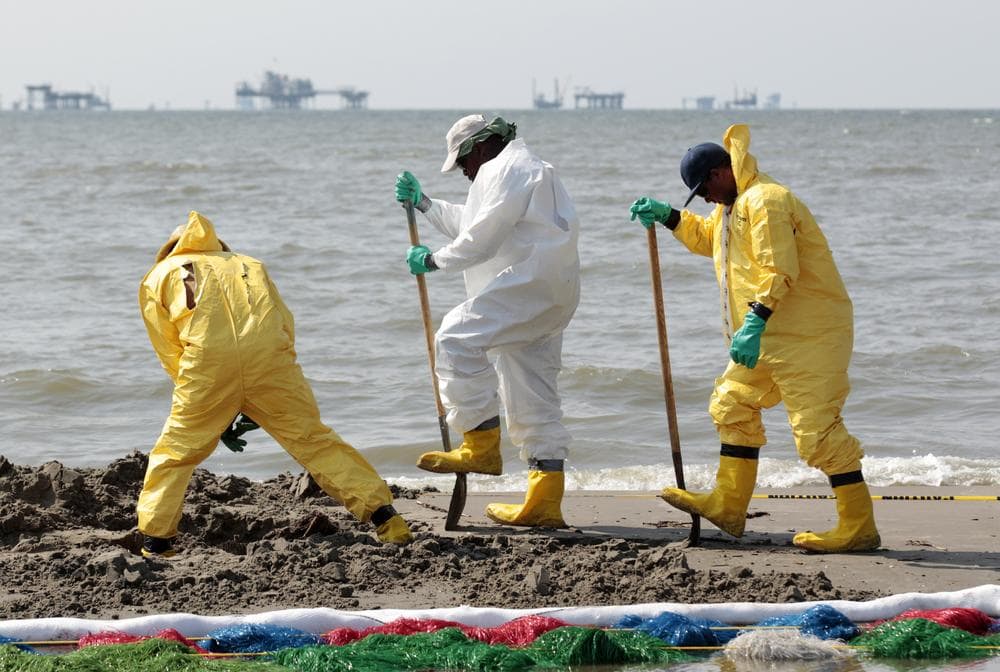Advertisement
BP Turns To Next Attempt After Top Kill Fails

Yet another mix of risky undersea robot maneuvers, containment devices and longshot odds is being prepared to fight the uncontrolled gusher feeding the worst oil spill in U.S. history.
Six weeks after the catastrophe began, oil giant BP PLC is still casting about for a way to slow down the spewing, blown-out well underneath the Gulf of Mexico that's fouling beaches, wildlife and marshland. A relief well being drilled that's considered the most reliable solution is at least two months away.
President Barack Obama on Saturday called the latest failure to stop the mess "as enraging as it is heartbreaking."
The most ambitious bid yet for a temporary fix ended in failure Saturday when BP said it was unable to overwhelm the broken well with heavy fluids and junk. The company determined the "top kill" had failed after it spent three days pumping heavy drilling mud into the crippled well 5,000 feet underwater.
Now, BP hopes to saw through a pipe leading out from the well and cap it with a funnel-like device using the same remotely guided undersea robots that have failed in other tries to stop the gusher.
The spill is the worst in U.S. history - exceeding even the 1989 Exxon Valdez disaster - and has dumped between 18 million and 40 million gallons into the Gulf, according to government estimates. The leak began after the Deepwater Horizon drilling rig exploded in April, killing 11 people.
"This scares everybody, the fact that we can't make this well stop flowing, the fact that we haven't succeeded so far," BP Chief Operating Officer Doug Suttles said Saturday. "Many of the things we're trying have been done on the surface before, but have never been tried at 5,000 feet."
Suttles said BP is already preparing for the next temporary fix. The company plans to use robot submarines to cut off the damaged riser, and then try to cap it with a containment valve. The effort is expected to take between four and seven days.
"We're confident the job will work but obviously we can't guarantee success," Suttles said of the new plan, declining to handicap the likelihood it will work.
He said cutting off the damaged riser isn't expected to cause the flow rate of leaking oil to increase significantly.
The supposed permanent solution to the leak, a relief well currently being drilled, won't be ready until August, BP says.
Experts have said that a bend in the damaged riser likely was restricting the flow of oil somewhat, so slicing it off and installing a new containment valve is risky.
"If they can't get that valve on, things will get much worse," said Philip W. Johnson, an engineering professor at the University of Alabama.
Johnson said he thinks BP can succeed with the valve, but added: "It's a scary proposition."
News that the top kill fell short drew a sharply worded response from President Obama on Saturday, a day after he visited the Gulf Coast to see the damage firsthand.
"It is as enraging as it is heartbreaking, and we will not relent until this leak is contained, until the waters and shores are cleaned up, and until the people unjustly victimized by this manmade disaster are made whole," Obama said.
In the days after the spill, BP was unable to use robot submarines to close valves on the massive blowout preventer atop the damaged well, then two weeks later, ice-like crystals clogged a 100-ton box the company tried placing over the leak. Earlier this week, engineers removed a mile-long siphon tube after it sucked up a disappointing 900,000 gallons of oil from the gusher.
Frustration has grown as drifting oil closes beaches and washes up in sensitive marshland. The damage is underscored by images of pelicans and their eggs coated in oil. Below the surface, oyster beds and shrimp nurseries face certain death. Fishermen complain there's no end in sight to the catastrophe that's keeping their boats idle.
In the latest try, BP engineers pumped more than 1.2 million gallons of heavy drilling mud into the well and also shot in assorted junk, including metal pieces and rubber balls.
The hope was that the mud force-fed into the well would overwhelm the upward flow of oil and natural gas. But Suttles said most of the mud escaped out of the damaged pipe that's leaking the oil, called a riser.
Word that the top-kill had failed hit hard in fishing communities along Louisiana's coast.
"Everybody's starting to realize this summer's lost. And our whole lifestyle might be lost," said Michael Ballay, the 59-year-old manager of the Cypress Cove Marina in Venice, La., near where oil first made landfall in large quantities almost two weeks ago.
Johnny Nunez, owner of Fishing Magician Charters in Shell Beach, La., said the spill is hurting his business during what's normally the best time of year - and there's no end in sight.
"If fishing's bad for five years, I'll be 60 years old. I'll be done for," he said after watching BP's televised announcement.
The top official in coastal Plaquemines Parish said news of the top kill failure brought tears to his eyes.
"They are going to destroy south Louisiana. We are dying a slow death here," said Billy Nungesser, the parish president. "We don't have time to wait while they try solutions. Hurricane season starts on Tuesday."
This program aired on May 30, 2010. The audio for this program is not available.